30th July 2014
By Marlow Renton
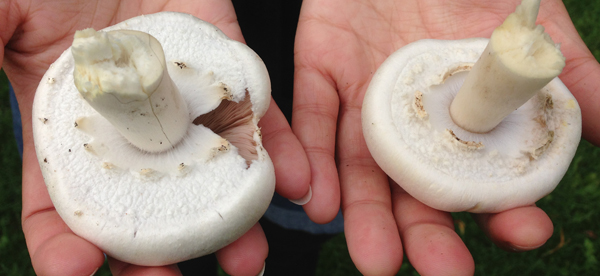 THIS ARTICLE APPLIES TO UK MUSHROOMS ONLY Of the two mushrooms in the photo above, one is a tasty, edible Horse Mushroom whereas the other is a poisonous Yellow Stainer. Both will stain yellow when bruised too; so how do you tell the difference?
THIS ARTICLE APPLIES TO UK MUSHROOMS ONLY Of the two mushrooms in the photo above, one is a tasty, edible Horse Mushroom whereas the other is a poisonous Yellow Stainer. Both will stain yellow when bruised too; so how do you tell the difference?
There are plenty of white mushrooms that stand out in the grass or the undergrowth because of their colour; but which of those can you eat safely?
Some of the most deadly mushrooms in the world are white. For example the beautifully named Destroying Angel pictured here on the right is deadly even in small quantities.
There are many other poisonous white mushrooms but also many that are great edibles, and reasonably easy to identify.
From what I read, it seems that white mushrooms are responsible for the majority of mushroom poisonings around the world.
So to help you forage safely, this article is about how to identify the easier edible white mushrooms, and avoid the poisonous ones.
Please always be 100% sure of what you are eating and use numerous sources of information and photography when confirming your mushrooms identification. There is no one simple rule to determine whether you have an edible or toxic mushroom, but if you can positively identify families of mushrooms, often there are simple ways to determine whether you have an edible member of that family.
Here are some things you should look for to try to determine what family your white mushroom is in and/or whether your white mushroom is edible:
- What size is it This article only applies to sizeable mushrooms, similar to those you buy in the shops with thick fleshy solid stems.It does not apply to small thin stemmed mushrooms such as Mycenas or small Wax Caps.There are many small white mushrooms, some like the snowy wax cap are perfectly edible, but often it is extremely difficult to tell the difference between species, so for reference sake this guide does not apply to any mushrooms with a stem less than 1cm in diameter.
- Is it growing from a tree trunk?There are a number of white mushrooms that grow from tree trunks, 2 are good edibles and fairly easy to identify.
 Small white mushrooms growing from a tree should be left behind, but the following 2 have key characteristics which make them easy to identify. First, Porcelain Fungus, Oudemansiella mucida, which is easy to recognise because of the glutinous substance all over the cap, as pictured on the right.It is almost exclusive to Beech trees and grows in late Summer and Autumn.This picture is of young specimens. On the more mature mushrooms the cap will open out to almost flat, up to 8cm across with slightly translucent flesh.Cleaning the glutenous substance off this mushroom makes them a slightly better proposition for cooking, but they are quite tasty when you do. Second, White Oyster Mushrooms, Pleurotus pulmonarius,
Small white mushrooms growing from a tree should be left behind, but the following 2 have key characteristics which make them easy to identify. First, Porcelain Fungus, Oudemansiella mucida, which is easy to recognise because of the glutinous substance all over the cap, as pictured on the right.It is almost exclusive to Beech trees and grows in late Summer and Autumn.This picture is of young specimens. On the more mature mushrooms the cap will open out to almost flat, up to 8cm across with slightly translucent flesh.Cleaning the glutenous substance off this mushroom makes them a slightly better proposition for cooking, but they are quite tasty when you do. Second, White Oyster Mushrooms, Pleurotus pulmonarius,  are almost exactly the same as the common grey oyster mushroom but white all over…These mushrooms are reasonably safe to identify as nothing else that is white and growing from a tree gets over 10cm across the cap.Oyster mushrooms have gills running all the way down the stem into the tree they are growing from.The photo on the right shows the start of the wavy edge you get to the cap on more mature specimens giving them the oyster look.There are a number of smaller mushrooms that may look similar so without a mature specimen of a reasonable size ID can be tricky.
are almost exactly the same as the common grey oyster mushroom but white all over…These mushrooms are reasonably safe to identify as nothing else that is white and growing from a tree gets over 10cm across the cap.Oyster mushrooms have gills running all the way down the stem into the tree they are growing from.The photo on the right shows the start of the wavy edge you get to the cap on more mature specimens giving them the oyster look.There are a number of smaller mushrooms that may look similar so without a mature specimen of a reasonable size ID can be tricky.
White Oyster Mushrooms are a choice edible. With a mushroomy flavour and fairly firm texture. They also have some other amazing uses which are talked about in the video on the right.
- Is it a puffball? Giant puffballs, Calvatia gigantea must
 be the easiest mushroom in the UK to identify! They get to the size of a football, roundish and white all over, with white flesh all the way through when cut. The flesh yellows with age before it turns into trillions of spores. We do not eat them after they start to yellow.They grow in and around the edges of fields, or sometimes in open woodland, often hiding among nettles. The only thing you could confuse them for would be a football making them a foragers favourite and safe for novices!The Giant Puffball is a choice edible with a fantastic flavour. The texture is not so good though so we use the giant puffball to make mushroom schnitzels by frying them in butter, then coating
be the easiest mushroom in the UK to identify! They get to the size of a football, roundish and white all over, with white flesh all the way through when cut. The flesh yellows with age before it turns into trillions of spores. We do not eat them after they start to yellow.They grow in and around the edges of fields, or sometimes in open woodland, often hiding among nettles. The only thing you could confuse them for would be a football making them a foragers favourite and safe for novices!The Giant Puffball is a choice edible with a fantastic flavour. The texture is not so good though so we use the giant puffball to make mushroom schnitzels by frying them in butter, then coating  them in some spiced breadcrumb and frying them again to crisp them up. This really is one of our favourite mushroom dishes.Of the smaller puffballs in the UK, all of the white ones are edible when young.To make sure you have a puffball simply cut through it. Puffballs have a fairly solid white spongy flesh all the way through, their lookalikes do not.Some are slightly warty like the Common Puffball in the photo on the right, and some will be smooth. But as long as it’s white it’s all right :)All the smaller puffballs have a spongy texture and a fairly mild flavour, making them ideal to soak up sauces and marinades before cooking.
them in some spiced breadcrumb and frying them again to crisp them up. This really is one of our favourite mushroom dishes.Of the smaller puffballs in the UK, all of the white ones are edible when young.To make sure you have a puffball simply cut through it. Puffballs have a fairly solid white spongy flesh all the way through, their lookalikes do not.Some are slightly warty like the Common Puffball in the photo on the right, and some will be smooth. But as long as it’s white it’s all right :)All the smaller puffballs have a spongy texture and a fairly mild flavour, making them ideal to soak up sauces and marinades before cooking.  Young Stinkhorns look like puffballs as shown in the picture on the right. Feeling this strange egg should put you off thinking it is a puffball but by cutting the mushroom in half you will find out what’s inside.Young stinkhorns have a glutenous substance inside, and the start of the spongy mushroom which is about to break out.Stinkhorn eggs are about most of the year but only emerge in the summer months.These mushrooms are actually edible if you can stand the smell!
Young Stinkhorns look like puffballs as shown in the picture on the right. Feeling this strange egg should put you off thinking it is a puffball but by cutting the mushroom in half you will find out what’s inside.Young stinkhorns have a glutenous substance inside, and the start of the spongy mushroom which is about to break out.Stinkhorn eggs are about most of the year but only emerge in the summer months.These mushrooms are actually edible if you can stand the smell! Young Amanitas also grown in an egg like sack with a baby mushroom inside.They could possibly be mistaken for a Puffball, as is illustrated in the photo on the right. Which is a young Death Cap Egg!It is obviously much more important to be able to recognise these as they could be deadly.Many other deadly Amanitas also grow exactly like this. So do be cautious when picking puffballs!
Young Amanitas also grown in an egg like sack with a baby mushroom inside.They could possibly be mistaken for a Puffball, as is illustrated in the photo on the right. Which is a young Death Cap Egg!It is obviously much more important to be able to recognise these as they could be deadly.Many other deadly Amanitas also grow exactly like this. So do be cautious when picking puffballs!
- Is it coming out of a sack or volva?
 If so, it is likely to be an Amanita and probably deadly so leave it alone!The Volva is very clearly shown in the photo on the right of a Death Cap Mushroom, Amanita phalloides. Although not all Amanitas have such an obvious volva they do all have a bulbous base, some with ‘guttering’ like the Panther Cap.The mushroom itself emerges from this egg like structure as shown in the photo above right. It starts off as a small white ball and could easily be mistaken for a puffball until you cut through them. If you cut an Amanita egg in half you will see a small mushroom inside ready to emerge, if it was a Puffball the interior should be plain bright white and spongy.The base or volva can be hidden underground or covered in leaf litter so it is important that you check the base of all mushrooms that you pick so you can rule out picking an Amanita by accident
If so, it is likely to be an Amanita and probably deadly so leave it alone!The Volva is very clearly shown in the photo on the right of a Death Cap Mushroom, Amanita phalloides. Although not all Amanitas have such an obvious volva they do all have a bulbous base, some with ‘guttering’ like the Panther Cap.The mushroom itself emerges from this egg like structure as shown in the photo above right. It starts off as a small white ball and could easily be mistaken for a puffball until you cut through them. If you cut an Amanita egg in half you will see a small mushroom inside ready to emerge, if it was a Puffball the interior should be plain bright white and spongy.The base or volva can be hidden underground or covered in leaf litter so it is important that you check the base of all mushrooms that you pick so you can rule out picking an Amanita by accident
- Does it have spikes under the cap instead of gills? If so, then it’s the aptly named Hedgehog fungus, Hydnum repandum, and a very sought after
 edible. It comes up in Autumn in many parts of the country.The Hydnum family has a few members in the UK; all have spikes instead of gills under the cap.The white version is the most common and easy to identify, the cap can get to 17cm across.This is one of the safest mushrooms for the novice forager to harvest.
edible. It comes up in Autumn in many parts of the country.The Hydnum family has a few members in the UK; all have spikes instead of gills under the cap.The white version is the most common and easy to identify, the cap can get to 17cm across.This is one of the safest mushrooms for the novice forager to harvest. - If it has gills what colour are they?
 If the gills are white then the mushroom is possibly poisonous. The cap and gills of the The Destroying Angel, the Spring Amanita, the Clitocybe Dealbata and the Clitocybe Rivulosa (right) are all white, and all are deadly. So a white mushroom with white gills is generally something to avoid.There are three exceptions to this rule that are edible, reasonably easy to recognise and have white gills. So we can recommend them to the reasonably experienced forager.First the St Georges Mushroom, pictured and video’d on the right. This mushroom is one of the few that grow in spring – normally just after St Georges Day. Hence the name, and apart from unseasonal occurrences of the above mentioned poisonous species, nothing that looks like it is poisonous at that time of year.
If the gills are white then the mushroom is possibly poisonous. The cap and gills of the The Destroying Angel, the Spring Amanita, the Clitocybe Dealbata and the Clitocybe Rivulosa (right) are all white, and all are deadly. So a white mushroom with white gills is generally something to avoid.There are three exceptions to this rule that are edible, reasonably easy to recognise and have white gills. So we can recommend them to the reasonably experienced forager.First the St Georges Mushroom, pictured and video’d on the right. This mushroom is one of the few that grow in spring – normally just after St Georges Day. Hence the name, and apart from unseasonal occurrences of the above mentioned poisonous species, nothing that looks like it is poisonous at that time of year. It has a very fleshy stem, a really fleshy cap that can grow up to 20cm across, and a distinctive sawdusty or mealy smell.The Gills are quite small taking up very little vertical space when you cut through the capThey will be growing in rings in grassland often in clumps of four or five together at different intervals around the ring.This is a fine edible with a fairly unique flavour. It’s great dried or used fresh in chicken and mushroom pies 🙂Second the Clitocybe Geotropa or
It has a very fleshy stem, a really fleshy cap that can grow up to 20cm across, and a distinctive sawdusty or mealy smell.The Gills are quite small taking up very little vertical space when you cut through the capThey will be growing in rings in grassland often in clumps of four or five together at different intervals around the ring.This is a fine edible with a fairly unique flavour. It’s great dried or used fresh in chicken and mushroom pies 🙂Second the Clitocybe Geotropa or  Trooping funnel, which is pretty easy to identify due to its size. It is a very large mushroom growing in long troops where the mature specimen’s caps grow into large upturned funnel shapes that can reach more than 20cm across. The mushroom can also reach 30cm in height or more and is usually to found late in the Autumn around the end of October and beguinning of November. As the photograph on the right shows why these mushrooms are sometimes known as Angels Wings. The size is important here as the deadly Clitocybe rivulosa is very similar but the cap size will only reach up to 10cm in diameter at most.
Trooping funnel, which is pretty easy to identify due to its size. It is a very large mushroom growing in long troops where the mature specimen’s caps grow into large upturned funnel shapes that can reach more than 20cm across. The mushroom can also reach 30cm in height or more and is usually to found late in the Autumn around the end of October and beguinning of November. As the photograph on the right shows why these mushrooms are sometimes known as Angels Wings. The size is important here as the deadly Clitocybe rivulosa is very similar but the cap size will only reach up to 10cm in diameter at most.
Third, The Giant Funnel, Leucopaxillus giganteus, which looks a bit like the Geotropa but with a much shorter, stouter stem and a .larger flatter funnel shaped cap up to 30cm across or more. These mushrooms tend to be earlier than the Trooping Funnel and usually appear in late Summer to Autumn. It’s a tasty mushroom but unfortunately maggots seem to really like this mushroom to and seem to infest it from quite early in its development. As it is usually a gregarious fungi some can be found maggot free if you are lucky.
There are other white mushrooms with white gills that are edible such as The Miller, but due to their similarities with poisonous species we do not recommend you pick them until you are a very experienced mushroom forager. The above mushrooms are all easy to regonise because of the key features mentioned.
- Do the gills exude milk when damaged?
 You must bruise the gills, to make sure it’s not a Milk Cap. These mushrooms are easy to identify as when the gills are bruised you will see a milky substance start to apparently lactate from the damaged area, as is clearly illustrated in the photo on the right, the milk can be a range of colours from white to green. Avoid all of these without further means of identification, the vast majority of milk caps growing in the UK are Toxic, and a number of the white ones certainly are.
You must bruise the gills, to make sure it’s not a Milk Cap. These mushrooms are easy to identify as when the gills are bruised you will see a milky substance start to apparently lactate from the damaged area, as is clearly illustrated in the photo on the right, the milk can be a range of colours from white to green. Avoid all of these without further means of identification, the vast majority of milk caps growing in the UK are Toxic, and a number of the white ones certainly are. - Are the gills brittle or flexible?
 Run your finger over the gills and see if they snap into little flat sections or bend back into place. You can also try snapping the stem to see how it breaks. This is to test whether you have a member of the Russula family or not. There are over 100 types of Russula in the UK and some of them have a white cap and white gills. Russula stems break a little like chalk, and the gills flake because they have a different cell structure to most other mushrooms, giving them the common name The Brittlegills. This is one of our favourite families of mushrooms, and being able to identify this family will make all your forays more fruitful as there are often many russulas around. Some of the white russulas are toxic though, so again without experience and further means of identification this article recommends you leave all white russulas behind. Most have white gills, so point 6 applies to these too for safe ID purposes.Identifying Russulas
Run your finger over the gills and see if they snap into little flat sections or bend back into place. You can also try snapping the stem to see how it breaks. This is to test whether you have a member of the Russula family or not. There are over 100 types of Russula in the UK and some of them have a white cap and white gills. Russula stems break a little like chalk, and the gills flake because they have a different cell structure to most other mushrooms, giving them the common name The Brittlegills. This is one of our favourite families of mushrooms, and being able to identify this family will make all your forays more fruitful as there are often many russulas around. Some of the white russulas are toxic though, so again without experience and further means of identification this article recommends you leave all white russulas behind. Most have white gills, so point 6 applies to these too for safe ID purposes.Identifying Russulas - Do the gills turn into an inky substance when crushed? The Coprinus family are commonly known as the Inkcap family as their gills deliquesce into a
 perfectly useable ink, either when you crush them or just by leaving the mushroom to do it itself. There are a number of Inkcap mushrooms. With the Shaggy Inkcap being by far the best edible. It is a fairly tall white capped mushroom, with a shaggy appearance to the cap. This is often compared to a judges or lawyers wig; hence both are common nicknames for it. It really is one of the best edibles around when young, but you will never find these in the shops or on restaurant menus as they have a shelf life of less than 48 hours, with more mature ones like the one pictured right lasting no more than a few hours once picked before turning into ink. So the only way you will ever get to taste a Shaggy Inkcap is if it has been foraged that day! Any other white or patchy white ink caps should not be eaten unless a positive ID can be made.The Magpie fungus in particular can look similar to the Shaggy Inkcap when young but is less shaggy and the white scales cover a black background. It is not deadly but it is poisonous so care should be taken when collecting these mushrooms, and they are perhaps not one for the novice forager.
perfectly useable ink, either when you crush them or just by leaving the mushroom to do it itself. There are a number of Inkcap mushrooms. With the Shaggy Inkcap being by far the best edible. It is a fairly tall white capped mushroom, with a shaggy appearance to the cap. This is often compared to a judges or lawyers wig; hence both are common nicknames for it. It really is one of the best edibles around when young, but you will never find these in the shops or on restaurant menus as they have a shelf life of less than 48 hours, with more mature ones like the one pictured right lasting no more than a few hours once picked before turning into ink. So the only way you will ever get to taste a Shaggy Inkcap is if it has been foraged that day! Any other white or patchy white ink caps should not be eaten unless a positive ID can be made.The Magpie fungus in particular can look similar to the Shaggy Inkcap when young but is less shaggy and the white scales cover a black background. It is not deadly but it is poisonous so care should be taken when collecting these mushrooms, and they are perhaps not one for the novice forager. - How to Identify an Agaric The main Genus that this article is about are the Agaricus mushrooms.They mostly all have a skirt on the stem, which can remain attached to the cap until the mushroom is quite mature; or partially attached to the cap as in the photo here on the right. They have stout, fleshy, solid stems, and the white cap can be fairly smooth to
 slightly coarse, both may discolour when bruised or cut. They all start with pink gills which darken to brown in maturity as shown in the images and videos on the right. Typically Agaric mushrooms look very much like the Button Mushrooms, Chestnut Mushrooms or Portobello mushrooms that you buy in shops and supermarkets. This is because all of those shop bought mushrooms are cultivated and farmed versions of one member of the wild Agaric family, the Agaricus bisporus.Agarics grow in a number of different environments but mainly in grassland.People often refer to them as field mushrooms, though along with the Field Mushroom itself, there are other Agarics that look almost identical and grow in fields. Some of those are toxic, so if you know you have an Agaric those toxic ones are the most important members of the family to be able to identify. So how do you do that?Once you know you have an Agaric
slightly coarse, both may discolour when bruised or cut. They all start with pink gills which darken to brown in maturity as shown in the images and videos on the right. Typically Agaric mushrooms look very much like the Button Mushrooms, Chestnut Mushrooms or Portobello mushrooms that you buy in shops and supermarkets. This is because all of those shop bought mushrooms are cultivated and farmed versions of one member of the wild Agaric family, the Agaricus bisporus.Agarics grow in a number of different environments but mainly in grassland.People often refer to them as field mushrooms, though along with the Field Mushroom itself, there are other Agarics that look almost identical and grow in fields. Some of those are toxic, so if you know you have an Agaric those toxic ones are the most important members of the family to be able to identify. So how do you do that?Once you know you have an Agaric
- Bruise It!
 Bruising a mushroom helps you identify it by the way the bruised area reacts with air. Some Agarics will bruise yellow, some slightly reddish brown and some will not bruise at all. One of the mushrooms in the Agaricus group is called the Yellow Stainer (right); it looks almost identical to a Field mushroom, and is poisonous. Though not deadly this mushroom can make you very ill. Its name does suggest the method for identifying it, though. Once bruised, or cut, the Yellow Stainer will bruise bright yellow in the affected areas. The Agaricus pilatianus which is also toxic, also stains yellow when bruised, but with this mushroom the bruising will be more prominent at the base of the stem. Horse mushrooms, Field mushrooms and Agaricus macrosporus all bruise slightly yellow too though, and are good edibles. Normally they will not discolour as vibrantly or as quickly. But there is one further test you can do to be sure you have an edible.
Bruising a mushroom helps you identify it by the way the bruised area reacts with air. Some Agarics will bruise yellow, some slightly reddish brown and some will not bruise at all. One of the mushrooms in the Agaricus group is called the Yellow Stainer (right); it looks almost identical to a Field mushroom, and is poisonous. Though not deadly this mushroom can make you very ill. Its name does suggest the method for identifying it, though. Once bruised, or cut, the Yellow Stainer will bruise bright yellow in the affected areas. The Agaricus pilatianus which is also toxic, also stains yellow when bruised, but with this mushroom the bruising will be more prominent at the base of the stem. Horse mushrooms, Field mushrooms and Agaricus macrosporus all bruise slightly yellow too though, and are good edibles. Normally they will not discolour as vibrantly or as quickly. But there is one further test you can do to be sure you have an edible. - Smell it! Look at the photo on the right. One is a
 lovely Horse Mushroom; one is a poisonous Yellow Stainer. You must be able to tell the difference if you want to pick from the Agaric family safely! Cutting the mushroom will enhance the smell. A smell of aniseed is good – it means you have a Horse mushroom, a Wood mushroom, an Agaricus excellens or one of the other edible types. A pleasant mushroomy smell probably means you have a Field mushroom or an Agaricus bitorquis, which are common. A faint smell of almonds means you probably have an Agaricus Macrosporus or a Prince, again both of these are fine edibles. What you are looking for with the smell is an unpleasant, carbolic, chemically or inky smell – this would indicate one of the poisonous members of the family. This rule only applies to Agarics, but the rule is that if it smells edible then it is, if it smells bad then it isn’t! Please forage with care and use numerous sources for identification of any wild mushrooms. Never eat anything from the wild unless you are 100% sure what it is! Happy Hunting!
lovely Horse Mushroom; one is a poisonous Yellow Stainer. You must be able to tell the difference if you want to pick from the Agaric family safely! Cutting the mushroom will enhance the smell. A smell of aniseed is good – it means you have a Horse mushroom, a Wood mushroom, an Agaricus excellens or one of the other edible types. A pleasant mushroomy smell probably means you have a Field mushroom or an Agaricus bitorquis, which are common. A faint smell of almonds means you probably have an Agaricus Macrosporus or a Prince, again both of these are fine edibles. What you are looking for with the smell is an unpleasant, carbolic, chemically or inky smell – this would indicate one of the poisonous members of the family. This rule only applies to Agarics, but the rule is that if it smells edible then it is, if it smells bad then it isn’t! Please forage with care and use numerous sources for identification of any wild mushrooms. Never eat anything from the wild unless you are 100% sure what it is! Happy Hunting!
Posted in Identifying Mushrooms and Plants






































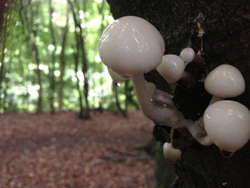 Small white mushrooms growing from a tree should be left behind, but the following 2 have key characteristics which make them easy to identify. First, Porcelain Fungus, Oudemansiella mucida, which is easy to recognise because of the glutinous substance all over the cap, as pictured on the right.It is almost exclusive to Beech trees and grows in late Summer and Autumn.This picture is of young specimens. On the more mature mushrooms the cap will open out to almost flat, up to 8cm across with slightly translucent flesh.Cleaning the glutenous substance off this mushroom makes them a slightly better proposition for cooking, but they are quite tasty when you do. Second, White Oyster Mushrooms, Pleurotus pulmonarius,
Small white mushrooms growing from a tree should be left behind, but the following 2 have key characteristics which make them easy to identify. First, Porcelain Fungus, Oudemansiella mucida, which is easy to recognise because of the glutinous substance all over the cap, as pictured on the right.It is almost exclusive to Beech trees and grows in late Summer and Autumn.This picture is of young specimens. On the more mature mushrooms the cap will open out to almost flat, up to 8cm across with slightly translucent flesh.Cleaning the glutenous substance off this mushroom makes them a slightly better proposition for cooking, but they are quite tasty when you do. Second, White Oyster Mushrooms, Pleurotus pulmonarius, 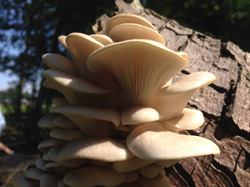 are almost exactly the same as the common grey oyster mushroom but white all over…These mushrooms are reasonably safe to identify as nothing else that is white and growing from a tree gets over 10cm across the cap.Oyster mushrooms have gills running all the way down the stem into the tree they are growing from.The photo on the right shows the start of the wavy edge you get to the cap on more mature specimens giving them the oyster look.There are a number of smaller mushrooms that may look similar so without a mature specimen of a reasonable size ID can be tricky.
are almost exactly the same as the common grey oyster mushroom but white all over…These mushrooms are reasonably safe to identify as nothing else that is white and growing from a tree gets over 10cm across the cap.Oyster mushrooms have gills running all the way down the stem into the tree they are growing from.The photo on the right shows the start of the wavy edge you get to the cap on more mature specimens giving them the oyster look.There are a number of smaller mushrooms that may look similar so without a mature specimen of a reasonable size ID can be tricky.
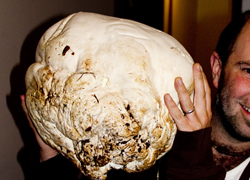 be the easiest mushroom in the UK to identify! They get to the size of a football, roundish and white all over, with white flesh all the way through when cut. The flesh yellows with age before it turns into trillions of spores. We do not eat them after they start to yellow.They grow in and around the edges of fields, or sometimes in open woodland, often hiding among nettles. The only thing you could confuse them for would be a football making them a foragers favourite and safe for novices!The Giant Puffball is a choice edible with a fantastic flavour. The texture is not so good though so we use the giant puffball to make mushroom schnitzels by frying them in butter, then coating
be the easiest mushroom in the UK to identify! They get to the size of a football, roundish and white all over, with white flesh all the way through when cut. The flesh yellows with age before it turns into trillions of spores. We do not eat them after they start to yellow.They grow in and around the edges of fields, or sometimes in open woodland, often hiding among nettles. The only thing you could confuse them for would be a football making them a foragers favourite and safe for novices!The Giant Puffball is a choice edible with a fantastic flavour. The texture is not so good though so we use the giant puffball to make mushroom schnitzels by frying them in butter, then coating 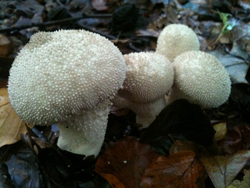 them in some spiced breadcrumb and frying them again to crisp them up. This really is one of our favourite mushroom dishes.Of the smaller puffballs in the UK, all of the white ones are edible when young.To make sure you have a puffball simply cut through it. Puffballs have a fairly solid white spongy flesh all the way through, their lookalikes do not.Some are slightly warty like the Common Puffball in the photo on the right, and some will be smooth. But as long as it’s white it’s all right :)All the smaller puffballs have a spongy texture and a fairly mild flavour, making them ideal to soak up sauces and marinades before cooking.
them in some spiced breadcrumb and frying them again to crisp them up. This really is one of our favourite mushroom dishes.Of the smaller puffballs in the UK, all of the white ones are edible when young.To make sure you have a puffball simply cut through it. Puffballs have a fairly solid white spongy flesh all the way through, their lookalikes do not.Some are slightly warty like the Common Puffball in the photo on the right, and some will be smooth. But as long as it’s white it’s all right :)All the smaller puffballs have a spongy texture and a fairly mild flavour, making them ideal to soak up sauces and marinades before cooking.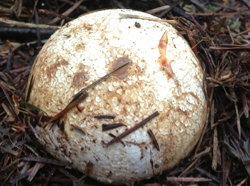 Young Stinkhorns look like puffballs as shown in the picture on the right. Feeling this strange egg should put you off thinking it is a puffball but by cutting the mushroom in half you will find out what’s inside.Young stinkhorns have a glutenous substance inside, and the start of the spongy mushroom which is about to break out.Stinkhorn eggs are about most of the year but only emerge in the summer months.These mushrooms are actually edible if you can stand the smell!
Young Stinkhorns look like puffballs as shown in the picture on the right. Feeling this strange egg should put you off thinking it is a puffball but by cutting the mushroom in half you will find out what’s inside.Young stinkhorns have a glutenous substance inside, and the start of the spongy mushroom which is about to break out.Stinkhorn eggs are about most of the year but only emerge in the summer months.These mushrooms are actually edible if you can stand the smell!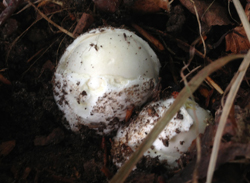 Young Amanitas also grown in an egg like sack with a baby mushroom inside.They could possibly be mistaken for a Puffball, as is illustrated in the photo on the right. Which is a young Death Cap Egg!It is obviously much more important to be able to recognise these as they could be deadly.Many other deadly Amanitas also grow exactly like this. So do be cautious when picking puffballs!
Young Amanitas also grown in an egg like sack with a baby mushroom inside.They could possibly be mistaken for a Puffball, as is illustrated in the photo on the right. Which is a young Death Cap Egg!It is obviously much more important to be able to recognise these as they could be deadly.Many other deadly Amanitas also grow exactly like this. So do be cautious when picking puffballs!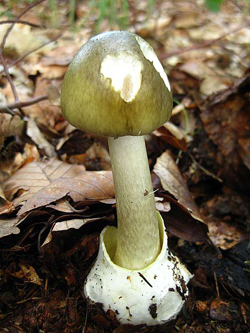 If so, it is likely to be an Amanita and probably deadly so leave it alone!The Volva is very clearly shown in the photo on the right of a Death Cap Mushroom, Amanita phalloides. Although not all Amanitas have such an obvious volva they do all have a bulbous base, some with ‘guttering’ like the Panther Cap.The mushroom itself emerges from this egg like structure as shown in the photo above right. It starts off as a small white ball and could easily be mistaken for a puffball until you cut through them. If you cut an Amanita egg in half you will see a small mushroom inside ready to emerge, if it was a Puffball the interior should be plain bright white and spongy.The base or volva can be hidden underground or covered in leaf litter so it is important that you check the base of all mushrooms that you pick so you can rule out picking an Amanita by accident
If so, it is likely to be an Amanita and probably deadly so leave it alone!The Volva is very clearly shown in the photo on the right of a Death Cap Mushroom, Amanita phalloides. Although not all Amanitas have such an obvious volva they do all have a bulbous base, some with ‘guttering’ like the Panther Cap.The mushroom itself emerges from this egg like structure as shown in the photo above right. It starts off as a small white ball and could easily be mistaken for a puffball until you cut through them. If you cut an Amanita egg in half you will see a small mushroom inside ready to emerge, if it was a Puffball the interior should be plain bright white and spongy.The base or volva can be hidden underground or covered in leaf litter so it is important that you check the base of all mushrooms that you pick so you can rule out picking an Amanita by accident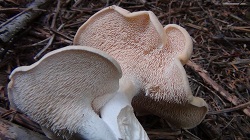 edible. It comes up in Autumn in many parts of the country.The Hydnum family has a few members in the UK; all have spikes instead of gills under the cap.The white version is the most common and easy to identify, the cap can get to 17cm across.This is one of the safest mushrooms for the novice forager to harvest.
edible. It comes up in Autumn in many parts of the country.The Hydnum family has a few members in the UK; all have spikes instead of gills under the cap.The white version is the most common and easy to identify, the cap can get to 17cm across.This is one of the safest mushrooms for the novice forager to harvest.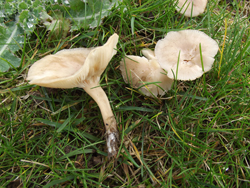 If the gills are white then the mushroom is possibly poisonous. The cap and gills of the The Destroying Angel, the Spring Amanita, the Clitocybe Dealbata and the Clitocybe Rivulosa (right) are all white, and all are deadly. So a white mushroom with white gills is generally something to avoid.There are three exceptions to this rule that are edible, reasonably easy to recognise and have white gills. So we can recommend them to the reasonably experienced forager.First the St Georges Mushroom, pictured and video’d on the right. This mushroom is one of the few that grow in spring – normally just after St Georges Day. Hence the name, and apart from unseasonal occurrences of the above mentioned poisonous species, nothing that looks like it is poisonous at that time of year.
If the gills are white then the mushroom is possibly poisonous. The cap and gills of the The Destroying Angel, the Spring Amanita, the Clitocybe Dealbata and the Clitocybe Rivulosa (right) are all white, and all are deadly. So a white mushroom with white gills is generally something to avoid.There are three exceptions to this rule that are edible, reasonably easy to recognise and have white gills. So we can recommend them to the reasonably experienced forager.First the St Georges Mushroom, pictured and video’d on the right. This mushroom is one of the few that grow in spring – normally just after St Georges Day. Hence the name, and apart from unseasonal occurrences of the above mentioned poisonous species, nothing that looks like it is poisonous at that time of year.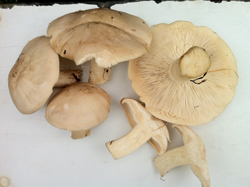 It has a very fleshy stem, a really fleshy cap that can grow up to 20cm across, and a distinctive sawdusty or mealy smell.The Gills are quite small taking up very little vertical space when you cut through the capThey will be growing in rings in grassland often in clumps of four or five together at different intervals around the ring.This is a fine edible with a fairly unique flavour. It’s great dried or used fresh in chicken and mushroom pies 🙂Second the Clitocybe Geotropa or
It has a very fleshy stem, a really fleshy cap that can grow up to 20cm across, and a distinctive sawdusty or mealy smell.The Gills are quite small taking up very little vertical space when you cut through the capThey will be growing in rings in grassland often in clumps of four or five together at different intervals around the ring.This is a fine edible with a fairly unique flavour. It’s great dried or used fresh in chicken and mushroom pies 🙂Second the Clitocybe Geotropa or 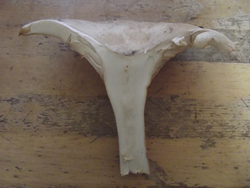 Trooping funnel, which is pretty easy to identify due to its size. It is a very large mushroom growing in long troops where the mature specimen’s caps grow into large upturned funnel shapes that can reach more than 20cm across. The mushroom can also reach 30cm in height or more and is usually to found late in the Autumn around the end of October and beguinning of November. As the photograph on the right shows why these mushrooms are sometimes known as Angels Wings. The size is important here as the deadly Clitocybe rivulosa is very similar but the cap size will only reach up to 10cm in diameter at most.
Trooping funnel, which is pretty easy to identify due to its size. It is a very large mushroom growing in long troops where the mature specimen’s caps grow into large upturned funnel shapes that can reach more than 20cm across. The mushroom can also reach 30cm in height or more and is usually to found late in the Autumn around the end of October and beguinning of November. As the photograph on the right shows why these mushrooms are sometimes known as Angels Wings. The size is important here as the deadly Clitocybe rivulosa is very similar but the cap size will only reach up to 10cm in diameter at most.
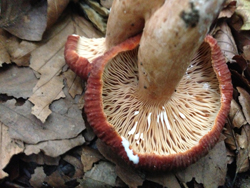 You must bruise the gills, to make sure it’s not a Milk Cap. These mushrooms are easy to identify as when the gills are bruised you will see a milky substance start to apparently lactate from the damaged area, as is clearly illustrated in the photo on the right, the milk can be a range of colours from white to green. Avoid all of these without further means of identification, the vast majority of milk caps growing in the UK are Toxic, and a number of the white ones certainly are.
You must bruise the gills, to make sure it’s not a Milk Cap. These mushrooms are easy to identify as when the gills are bruised you will see a milky substance start to apparently lactate from the damaged area, as is clearly illustrated in the photo on the right, the milk can be a range of colours from white to green. Avoid all of these without further means of identification, the vast majority of milk caps growing in the UK are Toxic, and a number of the white ones certainly are. 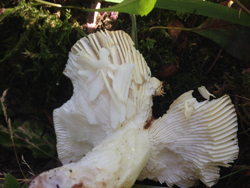 Run your finger over the gills and see if they snap into little flat sections or bend back into place. You can also try snapping the stem to see how it breaks. This is to test whether you have a member of the Russula family or not. There are over 100 types of Russula in the UK and some of them have a white cap and white gills. Russula stems break a little like chalk, and the gills flake because they have a different cell structure to most other mushrooms, giving them the common name The Brittlegills. This is one of our favourite families of mushrooms, and being able to identify this family will make all your forays more fruitful as there are often many russulas around. Some of the white russulas are toxic though, so again without experience and further means of identification this article recommends you leave all white russulas behind. Most have white gills, so point 6 applies to these too for safe ID purposes.Identifying Russulas
Run your finger over the gills and see if they snap into little flat sections or bend back into place. You can also try snapping the stem to see how it breaks. This is to test whether you have a member of the Russula family or not. There are over 100 types of Russula in the UK and some of them have a white cap and white gills. Russula stems break a little like chalk, and the gills flake because they have a different cell structure to most other mushrooms, giving them the common name The Brittlegills. This is one of our favourite families of mushrooms, and being able to identify this family will make all your forays more fruitful as there are often many russulas around. Some of the white russulas are toxic though, so again without experience and further means of identification this article recommends you leave all white russulas behind. Most have white gills, so point 6 applies to these too for safe ID purposes.Identifying Russulas 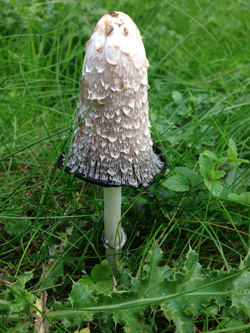 perfectly useable ink, either when you crush them or just by leaving the mushroom to do it itself. There are a number of Inkcap mushrooms. With the Shaggy Inkcap being by far the best edible. It is a fairly tall white capped mushroom, with a shaggy appearance to the cap. This is often compared to a judges or lawyers wig; hence both are common nicknames for it. It really is one of the best edibles around when young, but you will never find these in the shops or on restaurant menus as they have a shelf life of less than 48 hours, with more mature ones like the one pictured right lasting no more than a few hours once picked before turning into ink. So the only way you will ever get to taste a Shaggy Inkcap is if it has been foraged that day! Any other white or patchy white ink caps should not be eaten unless a positive ID can be made.The Magpie fungus in particular can look similar to the Shaggy Inkcap when young but is less shaggy and the white scales cover a black background. It is not deadly but it is poisonous so care should be taken when collecting these mushrooms, and they are perhaps not one for the novice forager.
perfectly useable ink, either when you crush them or just by leaving the mushroom to do it itself. There are a number of Inkcap mushrooms. With the Shaggy Inkcap being by far the best edible. It is a fairly tall white capped mushroom, with a shaggy appearance to the cap. This is often compared to a judges or lawyers wig; hence both are common nicknames for it. It really is one of the best edibles around when young, but you will never find these in the shops or on restaurant menus as they have a shelf life of less than 48 hours, with more mature ones like the one pictured right lasting no more than a few hours once picked before turning into ink. So the only way you will ever get to taste a Shaggy Inkcap is if it has been foraged that day! Any other white or patchy white ink caps should not be eaten unless a positive ID can be made.The Magpie fungus in particular can look similar to the Shaggy Inkcap when young but is less shaggy and the white scales cover a black background. It is not deadly but it is poisonous so care should be taken when collecting these mushrooms, and they are perhaps not one for the novice forager.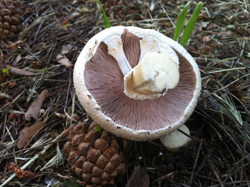 slightly coarse, both may discolour when bruised or cut. They all start with pink gills which darken to brown in maturity as shown in the images and videos on the right. Typically Agaric mushrooms look very much like the Button Mushrooms, Chestnut Mushrooms or Portobello mushrooms that you buy in shops and supermarkets. This is because all of those shop bought mushrooms are cultivated and farmed versions of one member of the wild Agaric family, the Agaricus bisporus.Agarics grow in a number of different environments but mainly in grassland.People often refer to them as field mushrooms, though along with the Field Mushroom itself, there are other Agarics that look almost identical and grow in fields. Some of those are toxic, so if you know you have an Agaric those toxic ones are the most important members of the family to be able to identify. So how do you do that?Once you know you have an Agaric
slightly coarse, both may discolour when bruised or cut. They all start with pink gills which darken to brown in maturity as shown in the images and videos on the right. Typically Agaric mushrooms look very much like the Button Mushrooms, Chestnut Mushrooms or Portobello mushrooms that you buy in shops and supermarkets. This is because all of those shop bought mushrooms are cultivated and farmed versions of one member of the wild Agaric family, the Agaricus bisporus.Agarics grow in a number of different environments but mainly in grassland.People often refer to them as field mushrooms, though along with the Field Mushroom itself, there are other Agarics that look almost identical and grow in fields. Some of those are toxic, so if you know you have an Agaric those toxic ones are the most important members of the family to be able to identify. So how do you do that?Once you know you have an Agaric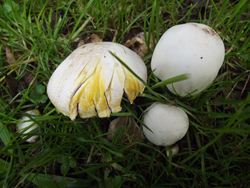 Bruising a mushroom helps you identify it by the way the bruised area reacts with air. Some Agarics will bruise yellow, some slightly reddish brown and some will not bruise at all. One of the mushrooms in the Agaricus group is called the Yellow Stainer (right); it looks almost identical to a Field mushroom, and is poisonous. Though not deadly this mushroom can make you very ill. Its name does suggest the method for identifying it, though. Once bruised, or cut, the Yellow Stainer will bruise bright yellow in the affected areas. The Agaricus pilatianus which is also toxic, also stains yellow when bruised, but with this mushroom the bruising will be more prominent at the base of the stem. Horse mushrooms, Field mushrooms and Agaricus macrosporus all bruise slightly yellow too though, and are good edibles. Normally they will not discolour as vibrantly or as quickly. But there is one further test you can do to be sure you have an edible.
Bruising a mushroom helps you identify it by the way the bruised area reacts with air. Some Agarics will bruise yellow, some slightly reddish brown and some will not bruise at all. One of the mushrooms in the Agaricus group is called the Yellow Stainer (right); it looks almost identical to a Field mushroom, and is poisonous. Though not deadly this mushroom can make you very ill. Its name does suggest the method for identifying it, though. Once bruised, or cut, the Yellow Stainer will bruise bright yellow in the affected areas. The Agaricus pilatianus which is also toxic, also stains yellow when bruised, but with this mushroom the bruising will be more prominent at the base of the stem. Horse mushrooms, Field mushrooms and Agaricus macrosporus all bruise slightly yellow too though, and are good edibles. Normally they will not discolour as vibrantly or as quickly. But there is one further test you can do to be sure you have an edible. 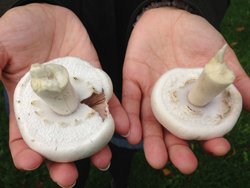 lovely Horse Mushroom; one is a poisonous Yellow Stainer. You must be able to tell the difference if you want to pick from the Agaric family safely! Cutting the mushroom will enhance the smell. A smell of aniseed is good – it means you have a Horse mushroom, a Wood mushroom, an Agaricus excellens or one of the other edible types. A pleasant mushroomy smell probably means you have a Field mushroom or an Agaricus bitorquis, which are common. A faint smell of almonds means you probably have an Agaricus Macrosporus or a Prince, again both of these are fine edibles. What you are looking for with the smell is an unpleasant, carbolic, chemically or inky smell – this would indicate one of the poisonous members of the family. This rule only applies to Agarics, but the rule is that if it smells edible then it is, if it smells bad then it isn’t! Please forage with care and use numerous sources for identification of any wild mushrooms. Never eat anything from the wild unless you are 100% sure what it is! Happy Hunting!
lovely Horse Mushroom; one is a poisonous Yellow Stainer. You must be able to tell the difference if you want to pick from the Agaric family safely! Cutting the mushroom will enhance the smell. A smell of aniseed is good – it means you have a Horse mushroom, a Wood mushroom, an Agaricus excellens or one of the other edible types. A pleasant mushroomy smell probably means you have a Field mushroom or an Agaricus bitorquis, which are common. A faint smell of almonds means you probably have an Agaricus Macrosporus or a Prince, again both of these are fine edibles. What you are looking for with the smell is an unpleasant, carbolic, chemically or inky smell – this would indicate one of the poisonous members of the family. This rule only applies to Agarics, but the rule is that if it smells edible then it is, if it smells bad then it isn’t! Please forage with care and use numerous sources for identification of any wild mushrooms. Never eat anything from the wild unless you are 100% sure what it is! Happy Hunting!




